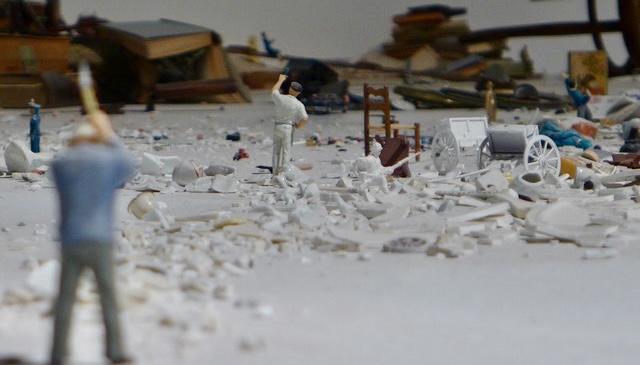Carl Rogers and Our Hunger for Deep Understanding
“… people so often go, “well, I listen, I listen, I know what you are talking about” – but really sensitive empathic understanding where you understand without judging, where you just understand what it´s like to live in the world of this other person, that is something so rare, that it is really precious, it ought to be regarded as we regarding precious gems or precious metals, because it is very rare in this world, and it has an enormously releasing effect” …. this is what Carl Rogers once said in an Interview.
Recently, I – Simone – began to think about scientists and psychologists who inspired me in my training as a psychotherapist. At university, we had to learn so many concepts and (of course) the entire history of psychotherapy, from the first psychiatric institutions to Freud and the therapeutic approaches that followed him.
So I learned a lot as a student – but Carl Rogers, his approach and his concepts, were the ones who truly transformed my personal experience. Deep listening truly made a difference. I was able to understand Rogers’ work and, as a young therapist, apply it immediately. I directly experienced how the therapeutic situation changed, how something opened up, how the work progressed.
Before we delve deeper into Rogers and his work, however, I’d like to start with some common misconceptions I later encountered when I was a trainer for young psychologists in client-centered group therapy— misconceptions that occurred when people were only vaguely familiar with Rogers’ work.
First, Roger’s approach isn’t passive. Deep listening isn’t just therapeutic nodding and “hmm”ing, not just repeating what the other person just has said. If you listen carefully, you’ll notice that clients often give you signals when you haven’t understood them correctly. Then they say, “Yes, but…” And it’s really worth pausing there and trying to understand exactly what the other person is trying to say.
People long for someone to understand them
Carl Rogers said: Active listening is one of the most powerful things you can do.
It is one of the most active, difficult things I know – to really get the situation of the other, to really understand what it´s like to be this person – but then it is also releasing, healing.
Second common misconception: It’s a nice idea, but it’s not science. Rogers and the people he worked with did an incredible amount of scientific work. His approach was both experimental and cognitive. Precise research was conducted, precisely defining which changes could be observed, in a wide variety of countries and settings – in therapy, schools, retirement homes, and universities – to demonstrate the effectiveness of this approach. And the effect has been very clearly demonstrated. One interesting result: The actual Self-image changes quickly in therapy, but not the image of the person they want to become. What changes is how we are, our behaviour, but not our values, i.e., what we want to become and achieve.
Third common misconception: This work is only for privileged, somewhat sophisticated, middle-class people. No. Rogers and his team worked with all kinds of people in a wide variety of countries, including South Africa, Brazil, Italy, Japan, Israel etc.
Fourth misconception: It´s somehow dry, lifeless. – No, not at all. Thanks to the internet, we now have the privilege of actually being able to listen to these wonderful teachers and see them online. Funnily enough, as a student and later as a young psychotherapist, I could only read their books, but today you can see Rogers’ wonderful lectures online: Not only was he kind and intelligent, but also had a wonderful sense of humor. And he said: Real relationships have the exciting quality of being alive and meaningful.
On Becoming a Person – Collected Essays from 1951 to 1961
All his earlier books Rogers wrote for professional psychologists; this book “On becoming a person” (1961) he wrote for people outside of this group – to give them courage and self-confidence.
“Man´s awesome scientific advances into the infinitude of space as well as the infinitude of sub-atomic particles seems most likely to lead to the total destruction of our world unless we can make great advances in understanding and dealing with interpersonal and intergroup tensions.”
He describes his own path to becoming a therapist and a case involving a mother and her son, an incident he describes as very important for the development of his own position and concept:
Rogers worked with the mother, focusing exclusively on her son’s behavior and giving her advice on how to get the boy “back on track” – but the work was extremely unsatisfying. He recognized that the boy’s problem clearly lay in his mother’s early rejection. However, he couldn’t “help” the mother. Finally, he gave up. As she was about to leave, she cautiously asked if Rogers also counseled adults. He was initially surprised, but agreed. When the woman sat down again and began to talk, she poured out her heart.
Now that she could speak freely, she described her marital problems, her difficult relationship with her husband, and her feelings of failure and confusion. Rogers was aware that the real therapy began precisely at that moment, when she could speak freely. Thus, he realized that “the client is the one who knows what hurts, which directions to go, which problems are crucial, which experiences have been deeply buried.“
“I slowly realised that if I didn’t need to demonstrate my cleverness and erudition, I would be better off relying on the client for the direction of the process.”
Some more quotes …
… on self-acceptance and congruence
“It doesn’t help to pretend to be something I’m not. It doesn’t help to appear calm and kind when I’m angry and critical. It doesn’t help to pretend I’m secure when I’m actually anxious and insecure… and so on… I’m more effective when I can listen to myself acceptingly and be myself.”
… on the paradox of change
Rogers called this the paradox of change: The more I am willing to understand and accept the realities within myself and/or the other person, the more change happens. Rogers calls this “one of the most profound insights” he has had in his personal and professional life. “We have to accept who we are, then the change seems to happen almost unnoticed.“
… on understanding and empathy
And he says, “I have found it of enormous value when I can permit myself to understand another person.” Why “permit”? He thought that this is necessary: We tend to have an immediate evaluation or judgement rather than an understanding. If I let myself really understand another person I might be changed by it. And that´s somehow risky. And it´s also rare that we do that.”
… on acceptance and unconditional positive regard
“I have found it very rewarding, when I can accept another person.” Rogers recognized an increasingly common pattern in our culture: “Everyone believes everyone else has to feel and think the way I do. But the autonomy of individuals is one of the most valuable potentials in life. If I can accept another person, their feelings, beliefs, etc., I’m supporting them in becoming a person – and that has great value in life.”
People are hungry to have some else understanding the person they are. Then they express feelings and conflicts, which can be solved, and personal growth occurs. People long for someone else to understand them as human beings. If that’s true, then it simply doesn’t make sense to satisfy their hunger for that with a substitute, just as the hunger for fresh food that we cook and prepare together and sit together cannot be satisfied with nutrient powder.
Roger’s core belief and experience, which has been confirmed for him time and time again: When you get to the core of a person – as he did in his therapeutic work – you arrive at something constructive, not destructive.
So, are people good? – We’ve already discussed this in relation to Rutger Bregman and his book “Human kind”. Carl Rogers said, he wouldn’t put it that way because that would be a judgmental way of seeing it.
He uses the metaphor of a plant: We wouldn’t say a plant is good or bad. Under the right conditions, it grows or blooms, it develops and lives its life, just like animals.
Only humans do we consider to be fundamentally evil. He hasn’t experienced that, said Rogers. Although he’s worked with many people who have done evil and socially destructive things, deep down you find a person who wants to live in harmony. That’s the essential foundation – even though people can stray very far from that foundation and become alienated from it. Rogers Grow Model means: as a therapist, he simply tried to remove whatever blocks the grow.
“The paradigm of Western society is that humans are inherently dangerous; therefore, they must be taught, guided, and controlled. But our experience… has shown that another paradigm is far more effective and constructive for both the individual and society. This paradigm states that, given a suitable climate, people are trustworthy, creatively self-motivated, energetic, and constructive …”
This is also very helpful in group conflicts: When you understand different sides, the irrational can be corrected; it becomes more objective. We become more understandable to one another. And we can develop respect for what we understand. We can become a corrective for one another, and the problems become more solvable – which is even more important for us today in these conflict-ridden times.




